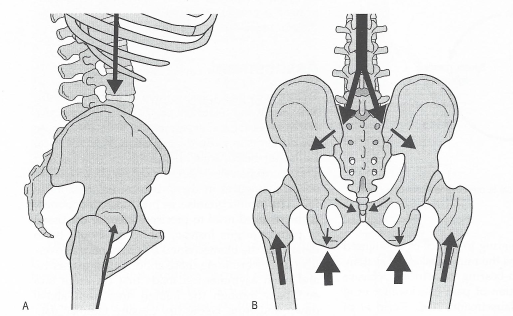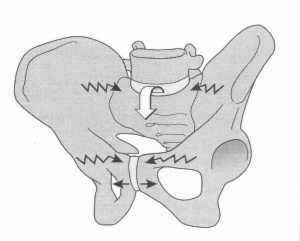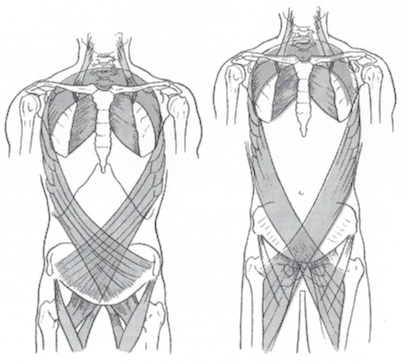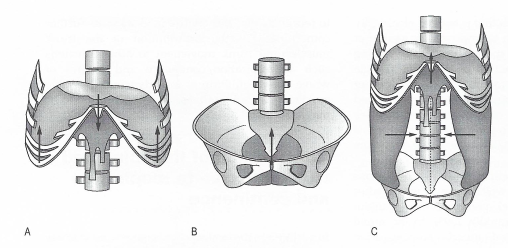Certain types of pain in the region of the pelvis and lower back can result from a problem called “Pelvic Stability Dysfunction”. This article explains how the pelvis functions as a foundation for movement. How problems with pelvic and lower back muscular stabilisation or support can result in pain and reduce the ability to perform daily tasks, or undertake exercise and activity without problems, and what can be done about it.
The pelvis function as a foundation and stable platform from which the spine, legs and arms can generate movement e.g. standing, walking, lifting. When working at its best the muscles across the pelvis are balanced in strength and tension to allow this function without placing excess demand or strain on a particular area.
The amount of muscle action in the legs, arms & spine needed for different types of body movement varies depending on the task. When more muscle force is required for a particular movement or task the stiffness across the pelvis needs to be increased to meet this demand. This is achieved by increasing the tension of muscles which attach to or cross over the pelvis. Ideally the muscles which stabilise the pelvis can match the demand placed on this area by the work or leverage of the spine, arms and legs, for example when walking, running, lifting or carrying.

What can happen if the muscles supporting the pelvis are not strong enough or unbalanced?
If there is not enough strength in the muscles stabilising the pelvis, the pelvis is unable to create the level of stiffness needed to meet the demand of the task or body movement – it has a weak foundation. A significant enough difference in the strength of the muscles in and around the pelvis from the left to the right side, called a ‘strength asymmetry’, can also create problems.
In both of these instances rather than the force of the muscles being evenly distributed throughout the ring structure of the pelvis, and the spine, there will be areas of higher or uneven load distribution on the pelvis, sacro-iliac joints or the lower back. Over time this can cause pain and stiffness in specific areas, a type of repetitive strain injury.
Excess stiffness and weakness across the pelvis can leave an individual vulnerable to pulling or straining a joint or muscle, as they are less able to time the contraction of their muscles correctly for the movements, resulting in a strain/sprain type injury. Typically, the more demanding the movement on a poorly stabilised pelvis and lower back, the more likely a strain would be. E.g. lifting shopping bags out of the car, reaching to pick up an item from the floor.

This problem at the pelvis is called: ‘Pelvic Stability Dysfunction’. It can occur:
- After lower back or pelvic injury.
- During or after pregnancy. Without specific strengthening / rehabilitation exercises after pregnancy Pelvic Stability Dysfunction to a greater or lesser degree is very common.
- Due to repetitive manual tasks - creating asymmetry in strength from left to right side or torsion across the pelvis.
- Reduced activity / increased sitting time - resulting in reduced muscular / core strength e.g. seated desk work.
- Increased activity that places excess demand on a pelvis which is already having problems with pelvic stability or is unable to meet the demand placed upon it by the activity. E.g. a) impact related exercise - running, HITT classes b) resistance training with too much weight or incorrect technique- squatting, kettlebells, deadlifts.
Examples of injury/pain which can be related to underlying Pelvic Stability Dysfunction include:
- Acute Lower back Pain - Lumbar facet joint sprain or lumbar musculature strain
- Chronic Lower Back Pain - repetitive overload / accumulative strain on the strucutures at the lower back - discs, facet joints, muscles
- Sacro-iliac joint pain
- Pubic symphysis dysfunction
- Groin strain
- Sciatica
- Piriformis syndrome
- Femoro acetabular impingement syndrome

How to improve function, reduce pain and increase capacity for daily tasks & activities.
Reduce the stiffness and pain of the joints and muscles in and around the pelvis.
When you are in pain, the muscles in and around the affected area have a reduced ability to function in a coordinated way to allow for good pelvic stabilisation.
Manual therapy such as muscle release, joint manipulation and acupuncture can be very effective in reducing pain and stiffness. When a certain severity of problem is reached it is possible that an individual would not be able to get out of pain with exercise alone. Needing manual therapy to reduce pain levels and balance muscle tension enough to allow for rehabilitation exercise(s) to be effective. Stretching can provide benefit by reducing muscle & joint stiffness.
Strengthen the stabilising muscles in and across the pelvis
So that the pelvis is able to meet the demands placed upon it, and evenly distribute load across the pelvis, lower back and upper legs. This is achieved by a specific and graduated exercise rehabilitation program to strengthen and stabilise weak areas, and to address left to right strength symmetries. It typically includes exercises for the following area:
- Gluteal muscles
- Deep core & abdominal wall muscular slings: transverse abdominal, internal oblique, and others muscles
- Pelvic floor activation
- Diaphragm function and breathing patterns
- The hip flexor (iliacus & psoas) muscles.
Once an individual has achieved a baseline of strength and co-ordination in the above, if needed, it is possible to progress to include movements and exercises more directly related to everyday tasks e.g. squatting and hip hinge movements.
Learning how to isolate and strengthen the pelvic floor, deep core & abdominal wall musculature is a co-ordination and skill-based learning curve that can be difficult to achieve without specific coaching from a qualified individual.
However some of the relevant exercises and stretches to improve pelvic stability and balance can usually be undertaken and performed well from video exercise instruction. Including:
- Side lying glut clamshell exercise using a resistance band
- Cat stretch
- Psoas / hip flexor stretching
- Gluteal / piriformis stretching
References:
- Movement, stability and Lumbopelvic Pain. Vleeming, Mooney and Stoeckart 2007. Pgs 61, 114, 394, 500,
- The Psoas Solution. Evan Osar 2017. Chapters 1, 2 & 3.

